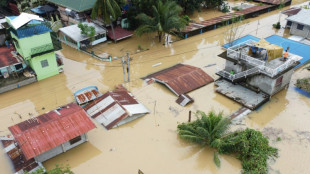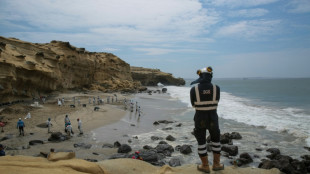
-
 Excited Osaka says 'deep love' of tennis keeps her going
Excited Osaka says 'deep love' of tennis keeps her going
-
Baseball superstar Ohtani expecting first baby

-
 For German 'sick leave detective', business is booming
For German 'sick leave detective', business is booming
-
Konstas, Khawaja fall as Australia extend lead to 158 over India

-
 Impressive Herbert leads Chargers into playoffs, Broncos denied
Impressive Herbert leads Chargers into playoffs, Broncos denied
-
One dead in Ecuador, Peru ports closed amid massive waves

-
 NBA hand out suspensions after fracas in Phoenix
NBA hand out suspensions after fracas in Phoenix
-
Atalanta snatch late draw at Lazio to hold Serie A lead

-
 Trump sides with Musk in right-wing row over worker visas
Trump sides with Musk in right-wing row over worker visas
-
Suriname rules out state funeral for ex-dictator Bouterse

-
 Alisson tells title-chasing Liverpool to create own history
Alisson tells title-chasing Liverpool to create own history
-
Israel army says ends raid against 'Hamas centre' in north Gaza hospital

-
 French skier Sarrazin 'stable' after surgery for crash injuries: federation
French skier Sarrazin 'stable' after surgery for crash injuries: federation
-
Israeli military confirms north Gaza hospital chief held in raid

-
 Abbas, Shahzad rock South Africa at start of chase
Abbas, Shahzad rock South Africa at start of chase
-
US deported record 61,680 Guatemalans in 2024: agency

-
 Double centurion Shah inspires Afghanistan fightback in Zimbabwe
Double centurion Shah inspires Afghanistan fightback in Zimbabwe
-
Diallo wants to make 'history' with struggling Man Utd

-
 Putin apologises to Azerbaijan without claiming responsibility in plane crash
Putin apologises to Azerbaijan without claiming responsibility in plane crash
-
Guardiola won't quit troubled Man City

-
 Gaza child amputees get new limbs but can't shake war trauma
Gaza child amputees get new limbs but can't shake war trauma
-
Evergreen Brignone powers to Semmering giant slalom win

-
 Thousands in Georgia human chain as pro-EU protests enter 2nd month
Thousands in Georgia human chain as pro-EU protests enter 2nd month
-
Turkey's pro-Kurd party meets jailed PKK leader

-
 WHO chief says narrowly escaped death in Israeli strikes on Yemen airport
WHO chief says narrowly escaped death in Israeli strikes on Yemen airport
-
Swiss Monney takes maiden World Cup win in Bormio downhill

-
 De Minaur wins but Australia crash to Argentina at United Cup
De Minaur wins but Australia crash to Argentina at United Cup
-
EU universal charger rules come into force

-
 Evenepoel targets return in time for Ardennes classics
Evenepoel targets return in time for Ardennes classics
-
Duffy bowls New Zealand to T20 victory over Sri Lanka

-
 Turkey's pro-Kurd party to meet jailed PKK leader on Saturday
Turkey's pro-Kurd party to meet jailed PKK leader on Saturday
-
Gaza hospital shut after Israeli raid, director held: health officials

-
 Surgery for French skier Sarrazin 'went well': federation
Surgery for French skier Sarrazin 'went well': federation
-
Mitchell, Bracewell boost New Zealand in Sri Lanka T20

-
 Kyrgios says tennis integrity 'awful' after doping scandals
Kyrgios says tennis integrity 'awful' after doping scandals
-
S. Korean prosecutors say Yoon authorised 'shooting' during martial law bid

-
 Vendee Globe skipper Pip Hare limps into Melbourne after dismasting
Vendee Globe skipper Pip Hare limps into Melbourne after dismasting
-
Reddy's defiant maiden ton claws India back into 4th Australia Test

-
 Doubles partner Thompson calls Purcell doping case 'a joke'
Doubles partner Thompson calls Purcell doping case 'a joke'
-
Reddy reaches fighting maiden century for India against Australia

-
 Sabalenka enjoying 'chilled' rivalry with Swiatek
Sabalenka enjoying 'chilled' rivalry with Swiatek
-
Political turmoil shakes South Korea's economy

-
 New mum Bencic wins first tour-level match since 2023 US Open
New mum Bencic wins first tour-level match since 2023 US Open
-
'Romeo and Juliet' star Olivia Hussey dies aged 73

-
 Brown dominates as NBA champion Celtics snap skid
Brown dominates as NBA champion Celtics snap skid
-
Indian state funeral for former PM Manmohan Singh

-
 France asks Indonesia to transfer national on death row
France asks Indonesia to transfer national on death row
-
Ambitious Ruud targets return to top five in 2025

-
 Late bloomer Paolini looking to build on 'amazing' 2024
Late bloomer Paolini looking to build on 'amazing' 2024
-
Australia remove Pant, Jadeja as India reach 244-7 at lunch


'You can't imagine the damage': Dam threatens historic Laos town
A short boat ride upstream from the ancient Laotian royal capital of Luang Prabang, a massive dam is under construction that critics say threatens the riverside town's allure and heritage status.
The $3 billion Luang Prabang hydroelectric dam on the Mekong river, backed by a Thai-led consortium, is one of seven new mainstream dams that Laos plans to build to capitalise on its huge hydro potential.
Experts warn that the barrage will change the contours of the Mekong's banks and turn the mighty waterway into a series of lakes -- detracting from the character of Luang Prabang as a riverside town and putting at risk its UNESCO listing.
With its blend of traditional Laotian and colonial French architecture, Luang Prabang has long been one of the poor, reclusive country's major tourist draws.
Many people working in the town's tourism industry fear their livelihoods are at risk.
"Once they have the dam the Mekong will be different: it will be just like a pool," a tour guide in Luang Prabang told AFP.
Laos is a one-party communist state that does not tolerate dissent, and like many of those who spoke to AFP for this story, the tour guide did so on condition of anonymity.
"Once they complete the dam, you can't imagine the damage for tourists," the guide said.
"Now it is beautiful, you can see the rocks, the river, the gardens on the riverbank," he said.
"The environment will change."
- Slowing the flow -
Laos, which is grappling with high inflation, slack economic growth and "critical levels" of public debt according to the World Bank, has sought to turn itself into the "battery of Southeast Asia" by exporting clean energy generated by hydroelectric plants to its more developed neighbours.
The 80-metre-high, 275-metre-wide Luang Prabang dam is due to finish in 2030, Laotian media reported. It will generate 1,460 megawatts of power, the bulk of which will be exported to Thailand and Vietnam.
Two downstream barrages, the Xayaburi and Don Sahong facilities, are already operational.
Conservationists say the dams, in addition to others upriver in China, are causing low water levels along the Mekong and wrecking fishing that millions rely on for food.
NGO International Rivers has warned the dams will "block the major fish migrations that feed and provide income to millions of people, and threaten the ecological integrity of the entire river system".
World heritage body UNESCO, which listed Luang Prabang in 1995, has repeatedly warned of threats to the site.
In its latest report late last year, it said Luang Prabang had "urgent conservation needs" and exhorted the government to take action.
Among the requirements are impact studies to answer concerns the dam will affect the protected area, it said.
Dams can change a river's water levels and rate of flow, which in turn can alter the shape and contours of its banks.
But Anda Yangsenexay, deputy head of Luang Prabang World Heritage Management Division, insisted there was no issue with the construction of the hydro dam.
"We are trying to explain to everyone. Dams are necessary and the dams are not in town," he told AFP.
"We know there was some disagreement from UNESCO, but we are trying to explain that now we think there is no problem," he said, before adding that authorities would deliver impact studies.
"Conservationists have to accept that there must be development. Both must go together," he said.
Luang Prabang residents fear changes to the river caused by the dam could deter tourists.
"The dam is very bad," said a 25-year-old waiter, cleaning tables in a near-empty riverbank restaurant.
He pointed at a semi-submerged promontory, peeking from the muddy water, "before you could see rocks and there was a nice scene for tourists. Now there are fewer boats."
But locals are resigned: one 37-year-old asked about the dam's impact shrugged.
"High-ranking officials already signed the contract," he said. "I don't dare to speak."
R.J.Fidalgo--PC




